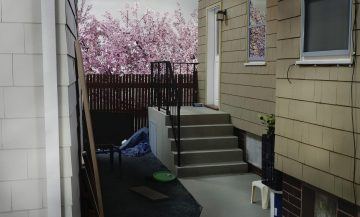Morgan Meis in The Easel:

It should be mentioned that Backyard is a huge C-Print (91 X 150 inches) mounted on plexiglass and without any frame. The mundanity of the image is therefore partially offset by its commanding presence. Looking at the large, high resolution image, one can study the details of the scene. A few minutes of such study generally creates a sense of unease in the viewer. Something is wrong here. The problem is not so much in the overall content of the scene, or in its composition. Rather, many of the details in the picture just don’t look right. There are, for instance, several small pieces of dirt and refuse on the concrete steps that lead up to the door of the house on the right of the picture. But the bits of dirt do not look like real dirt. The dirt just isn’t dirty enough to be real dirt. Nor, at second glance, is the concrete rough and heavy enough in its appearance to be real concrete. And the light – the illumination on the steps doesn’t seem at all consistent with the overcast sky, just beyond those blossoming trees.
The secret is that Backyard is not a photograph of a real backyard at all. It is a photograph of a “fake” backyard, a life-sized model of a backyard made by Demand out of paper and cardboard. Even the beautifully flowering trees in the background are paper models. The plastic is not plastic, it is colored cardboard. Every single object in the picture has been constructed by Demand (and his assistants), which he then photographed. After the photograph was taken, the cardboard and paper model was destroyed. So, the photograph is the only documentation of the existence of this backyard.
More here.
